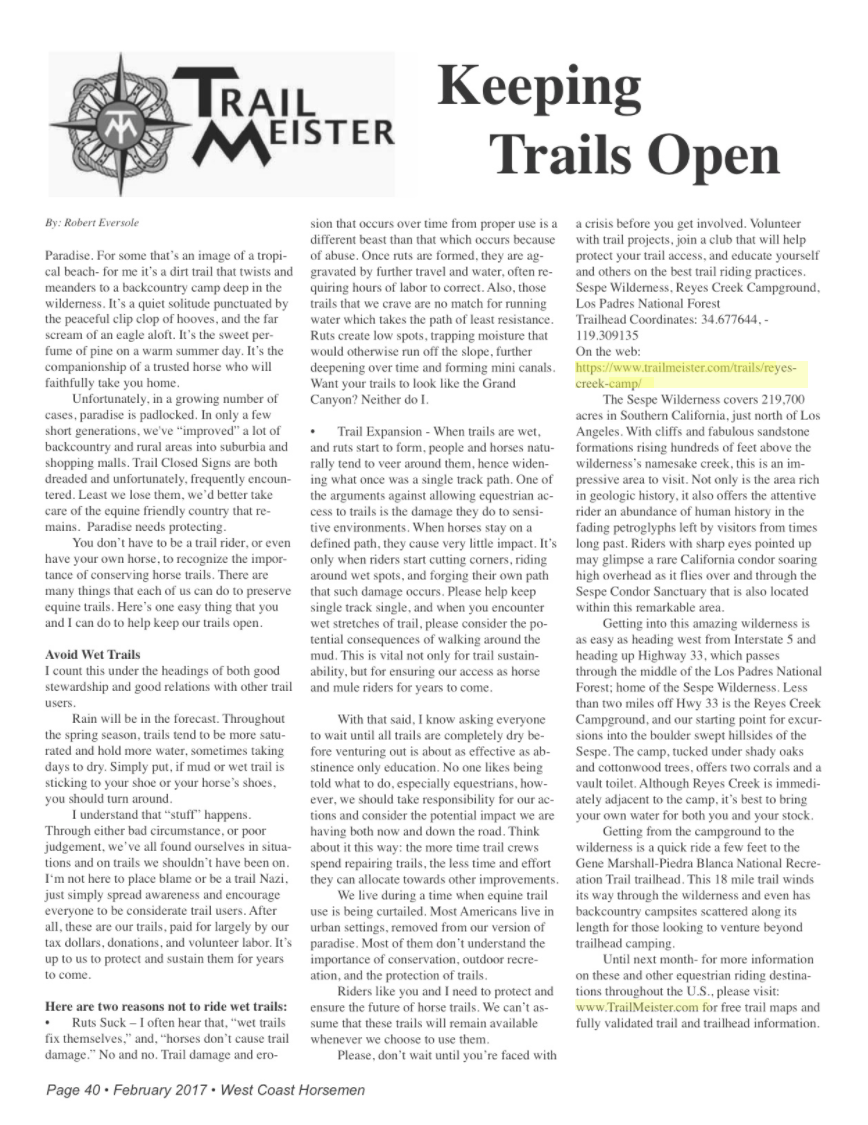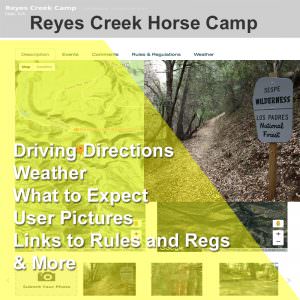 As Published in the FEB 2017 issue of West Coast Horsemen Magazine – Keeping Trails Open – and the Reyes Creek Horse Camp
As Published in the FEB 2017 issue of West Coast Horsemen Magazine – Keeping Trails Open – and the Reyes Creek Horse Camp
Paradise. For some that’s an image of a tropical beach, for me, it’s a dirt trail that twists and meanders to a backcountry camp deep in the wilderness. It’s a quiet solitude punctuated by the peaceful clip clop of hooves and the far scream of an eagle aloft. It’s the sweet perfume of pine on a warm summer day. It’s the companionship of a trusted horse who will faithfully take you home.
Unfortunately, in a growing number of cases paradise is padlocked.
In only a few short generations we’ve “improved” a lot of backcountry and rural areas into suburbia and shopping malls. Trail Closed signs are both dreaded and unfortunately frequently encountered. Least we lose them, we’d better take care of the equine friendly country that remains. Paradise needs protecting.
You don’t have to be a trail rider, or even have your own horse, to recognize the importance of conserving horse trails. There are many things that each of us can do to preserve equine trails. Here’s one easy thing that you and I can do to help keep our trails open.
Avoid Wet Trails
I count this under the headings of both good stewardship and good relations with other trail users.
Rain will be in the forecast. Throughout the spring season, trails tend to be more saturated and hold more water, sometimes taking days to dry. Simply put, if mud or wet trail is sticking to your shoe or your horse’s shoes, you should turn around.
I understand that “stuff” happens. Through either bad circumstance or poor judgment, we’ve all found ourselves in situations and on trails we shouldn’t have been on. I‘m not here to place blame, or be a trail Nazis, but simply to spread awareness and encourage everyone to be considerate trail users. After all, these are our trails, paid for largely by our tax dollars, donations, and volunteer labor. It’s up to us to protect and sustain them for years to come.
Here are two reasons not to ride wet trails.
Ruts Suck – I often hear that “wet trails fix themselves” and “horses don’t cause trail damage.” No and no. Trail damage and erosion that occurs over time from proper use is a different beast than that which occurs because of abuse. Once ruts are formed, they are aggravated by further travel and water, often requiring hours of labor to correct. Also, those trails that we crave are no match for running water which takes the path of least resistance. Ruts create low spots trapping moisture that would otherwise run off the slope, further deepening over time and forming mini canals. Want your trails to look like the Grand Canyon? Neither do I.
- Trail Expansion – When trails are wet, and ruts start to form, people and horses naturally tend to veer around them, hence widening what once was a singletrack path. One of the arguments against allowing equestrian access to trails is the damage they do to sensitive environments. When horses stay on a defined path, they cause very little impact. It’s only when riders start cutting corners, riding around wet spots, and forging their own path that such damage occurs. Please help keep singletrack single, and when you encounter wet stretches of trail, please consider the potential consequences of walking around the mud. This is vital not only for trail sustainability but for ensuring our access as horse and mule riders for years to come.
With that said, I know asking everyone to wait until all trails are completely dry before venturing out is about as effective as abstinence-only education. No one likes being told what to do, especially equestrians, however, we should take responsibility for our actions and consider the potential impact we are having both now and down the road. Think about it this way: the more time trail crews spend repairing trails, the less time and effort they can allocate towards other improvements.
We live during a time when equine trail use is being curtailed. Most Americans live in urban settings, removed from our version of paradise. Most of them don’t understand the importance of conservation, outdoor recreation, and the protection of trails.
Riders like you and I need to protect and ensure the future of horse trails. We can’t assume that these trails will remain available whenever we choose to use them.
Please, don’t wait until you’re faced with a crisis before you get involved. Volunteer with trail projects, join a club that will help protect your trail access and educate yourself and others on best trail riding practices.
Sespe Wilderness, Reyes Creek Campground, Los Padres National Forest
Trailhead Coordinates: 34.677644, -119.309135
On the web: https://www.trailmeister.com/trails/reyes-creek-camp/
The Sespe Wilderness covers 219,700 acres in Southern California, just north of Los Angeles. With cliffs and fabulous sandstone formations rising hundreds of feet above the wilderness’s namesake creek this is an impressive area to visit. Not only is the area rich in geologic history it also offers the attentive rider an abundance of human history in the fading petroglyphs left by visitors from times long past. Riders with sharp eyes pointed up may glimpse a rare California condor soaring high overhead as it flies over and through the Sespe Condor Sanctuary that is also located within this remarkable area.
Getting into this amazing wilderness is as easy as heading west from Interstate 5 and heading up highway 33, which passes through the middle of the Los Padres National Forest; home of the Sespe Wilderness. Less than two miles off Hwy 33 is the Reyes Creek Campground and our starting point for excursions into the boulder swept hillsides of the Sespe. The camp, tucked under shady oaks and cottonwood trees, offers two corrals and a vault toilet. Although Reyes Creek is immediately adjacent to the camp it’s best to bring your own water for both you and your stock.
Getting from the campground to the wilderness is a quick ride a few feet to the Gene Marshall-Piedra Blanca National Recreation Trail trailhead. This 18 mile trail winds its way through the wilderness and even has backcountry campsites scattered along its length for those looking to venture beyond trailhead camping.



